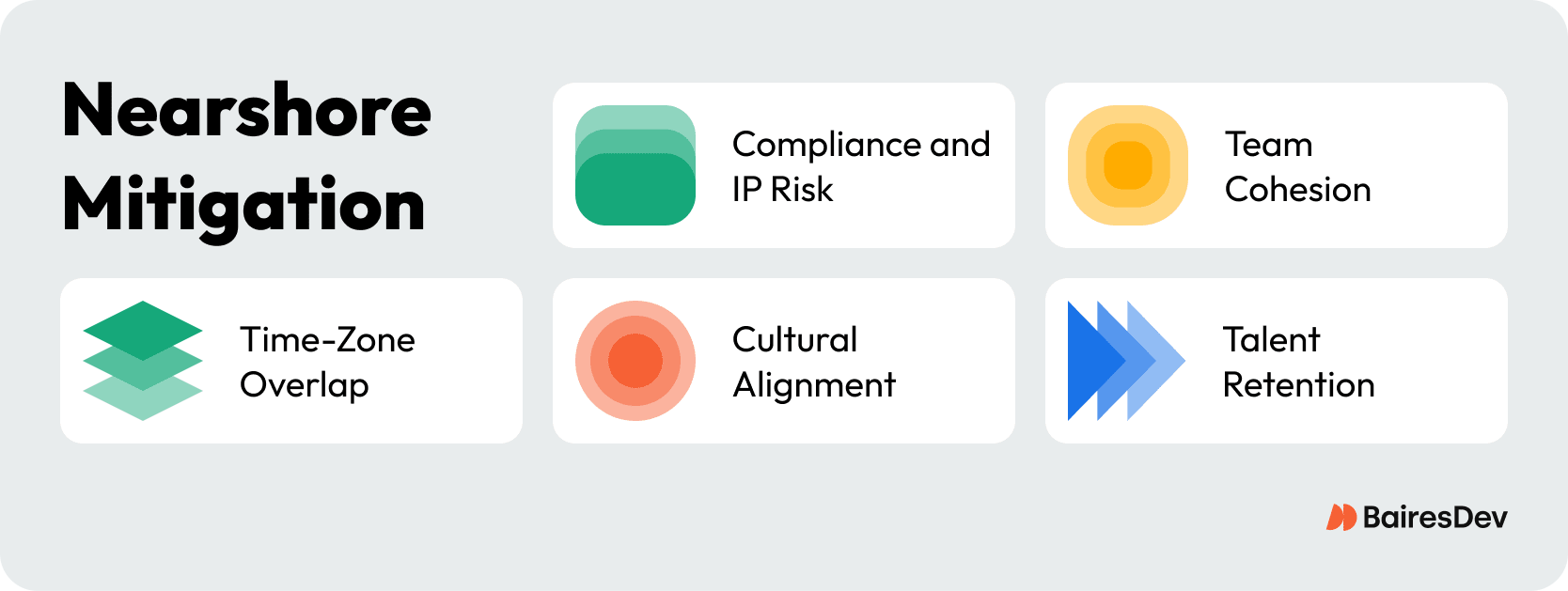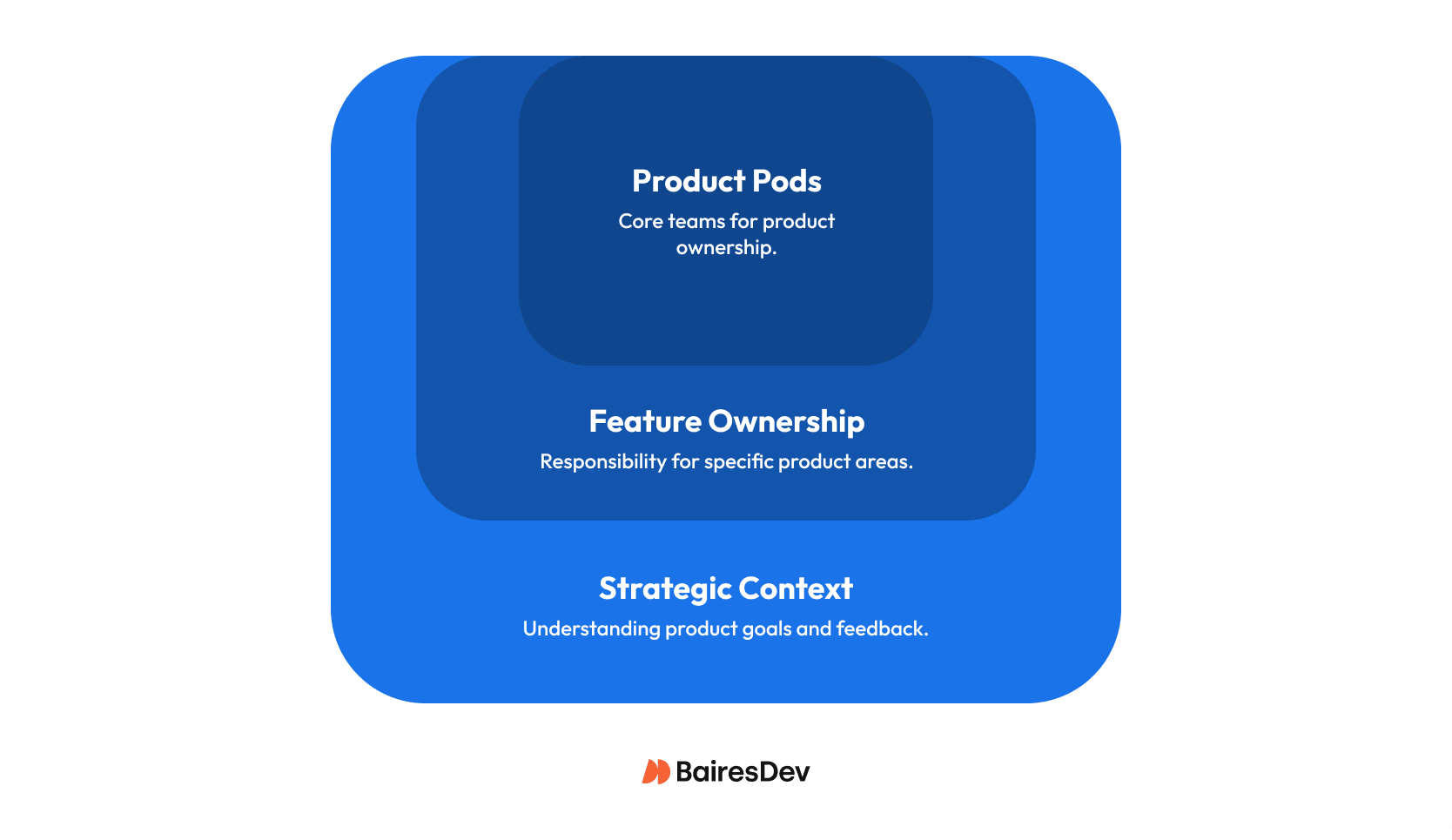Imagine your U.S. team completes a feature update late Wednesday. The offshore team in South Asia picks it up on Thursday, but a subtle contract change wasn’t documented clearly. When they implement their part of the update, it conflicts with the earlier work.
The result: a three-day delay in development as the teams scramble to untangle dependencies, retest the feature, and coordinate a corrected rollout. This delay cascades across the software supply chain, slowing downstream tasks and holding up QA.
The issue wasn’t code quality. It wasn’t project complexity or an incompetent software development team. It was timing.
Global Software Outsourcing: A Paradigm Shift
Over the past decade, outsourcing has become standard practice in software development, providing companies with strategic benefits such as low-cost human capital, access to global talent pools, and increased scalability of project teams.
Yet, the offshoring model also introduces management inefficiencies such as time-zone misalignment and cultural and linguistic barriers that can threaten project delivery.
And while offshoring remains dominant for cost savings, nearshoring has emerged as a refined variant of this model, retaining the global talent reach and cost efficiencies of offshoring but with closer proximity, overlapping time zones, and stronger cultural alignment.
Senior IT decision-makers are already making the shift: Deloitte reports that 65% of organizations now favor proximity-based outsourcing for its efficiency, and research cited by PITON Global shows offshore rollouts take 30% to 40% longer on average than nearshore, increasing timelines from about 4 to 5 months to 6 to 8 months. For enterprises under pressure to move quickly and reduce delivery risk, nearshoring is emerging as the new norm.
Nearshoring also offers practical advantages for U.S. companies in particular. Partnerships registered in the U.S. simplify procurement and provide stronger protections around data and intellectual property.
Just as important, effective delivery still relies on a strong project management function. With the oversight and guidance of these skilled software project leaders, nearshore teams can become strategic partners in maximizing the efficiency of software delivery.
This article walks IT decision-makers through the advantages of adopting the nearshoring model together with sound project management practices to support it. In sum: While your competitor’s offshore software engineers are asleep, your nearshore teams will be building momentum together, in real time.
The Benefits of Nearshore Software Development
Software project managers are all too familiar with the challenges of working with globally distributed teams. In addition to intricate scheduling around far-flung time zones, they contend with bridging language and cultural barriers and regularly onboarding new team members.
Moreover, when work crosses international boundaries, scheduling and cultural conflicts are not the only potential hazards; compliance and intellectual property issues also present significant risk not only to projects but to the enterprise.
Risks of Offshore Development vs. Nearshore Mitigation |
|
| Offshore Risk | Nearshore Mitigation |
| Delayed feedback due to time-zone gaps | Time-zone overlap enables real-time collaboration, tighter feedback loops, and faster issue resolution. |
| Miscommunication from cultural or language barriers | Shared culture and work norms improve trust, reduce misunderstandings, and speed decision-making. |
| Fragmented teams and poor integration with in-house staff | Nearshore teams integrate more easily, joining standups, reviews, and ceremonies in shared hours to build stronger cohesion. |
| High turnover and loss of institutional knowledge | Competitive compensation and closer integration foster higher retention, preserving continuity and long-term expertise. |
| Compliance gaps and IP risk across international jurisdictions | U.S.-registered nearshore partnerships share U.S./EU data and IP standards, simplifying compliance and reducing legal exposure. |
These mitigations show that nearshoring is not a facile staffing decision. It’s an easy-to-implement operating model that strengthens how teams collaborate, build trust, and deliver.

Here is a closer look at each of the benefits that nearshore partnerships can create:
Time-Zone Overlap
Even a couple of overlapping hours during the workday shortens feedback loops and reduces lag. This is particularly crucial for agile project teams handling incident response, sprint planning, and potential blockers.
Cultural Alignment
Shared cultural context enables nearshore teams to establish trust faster because they have similar communication styles and cultural norms as their onshore counterparts.
Team Cohesion
Nearshore teams are better able to onboard with in-house teams. By attending ceremonies, code reviews, and even all-hands meetings, they acclimate swiftly and integrate more easily with the core engineering team.
Better Talent Retention
Related to the above, nearshoring promotes team stability. More competitive compensation compared to offshore teams and closer relationships with in-house staff create favorable conditions for knowledge management and business continuity.
Lower Compliance and IP Risk
Because nearshore teams often share U.S. and EU data privacy and intellectual property laws, the sourcing model offers better legal protections and simpler compliance terms.
The advantages of nearshoring make a strong case for IT leaders seeking to reduce risk while accelerating software delivery. And while nearshoring can set up companies for these benefits, the results can only become tangible through thoughtful execution.
That’s where project management strategy comes in.
Activating Proximity: Project Management Tips for Nearshore Teams
Assembling a geographically well-positioned team is one thing, but activating it is another.
That requires a top-shelf project management function—professionals who can fold nearshore talent seamlessly into in-house operations and cross-functional team dynamics. They don’t think of nearshore contributors as external or temporary support, but rather consider them as vital project team constituents.
It’s not reinventing the wheel. Sound project management practices will positively impact any project team, but there are specific considerations worth noting when managing software development in a nearshoring context:
Time-zone Overlap for Real-time Collaboration
Effective project managers know how to strike the right balance between guidance and autonomy. In a nearshore project context, this means ensuring communication tools are used optimally, when working together, and apart.
The following practices will help keep teams connected when it counts:
- Set a regular meeting cadence: Schedule daily check-ins, weekly progress reviews, and monthly strategic sessions to maintain alignment.
- Use live working sessions: Try pair programming or real-time code reviews to keep team members engaged and productivity moving.
- Establish instant messaging channels: Use Slack or Teams for on-the-fly feedback and real-time communication with distributed team members during shared working hours.
- Adopt clear communication protocols: Safeguard your team’s valuable time; spell out what merits an instant message, what belongs in a GitHub issue, and what should be included in a long-form technical design doc.
Cross-functional Pods To Engage Strategic Thinking
Proper communication channels and practices keep the work moving efficiently. To further reinforce the team’s and product’s durability, project managers should provide a full-picture view of how the smaller pieces of work connect to larger outcomes.
Fostering a cottage industry, or small workshop environment, with cross-functional pods inspires nearshore team members to feel committed to achieving tangible goals and accountable for their contributions.

Look at this as an ascending three-step process, from building the pod to assigning work items to using strategic solutioning:
- Organize nearshore engineers into product pods: Include product owners, designers, and QA to facilitate end-to-end ownership.
- Assign ownership of features, services, or user journeys: Rather than allocating tickets task by task for individuals to work on in isolation, assign features or user journeys to cross-functional pods. This makes handoffs easier, speeds up delivery, and strengthens team engagement.
- Share strategic context: Involve nearshore teams in discussions around product roadmapping, business goals, and user feedback. Knowing the “why” behind the “what” they are building empowers teams to anticipate needs and suggest improvements.
Clear Documentation for Short- and Long-term Delivery
While agile practices discourage overdocumentation, remote teams still rely on thoughtful documentation to develop and perpetuate working software.
A strong project manager ensures just enough detail is captured to support smooth handoffs between in-house and nearshore engineers and to preserve critical knowledge for future development.
- Create documentation at every project stage: Include requirements, design, testing, deployment, and beyond. Don’t forget to capture lessons learned after each sprint or major event.
- Use collaborative tools: GitHub, Notion, or Confluence will help organize a centralized version-control repository accessible to the entire team.
- Make reporting easy, repeatable, and accessible: Use templates and record short video recaps or walkthroughs so team members can catch up on their own time.
On-call Shifts and Escalation Procedures
Managing incidents across in-house and nearshore teams demands foresight and structure; project managers orchestrate these work processes using on-call shifts and by preparing clear escalation procedures. They ensure every engineer knows when to act, how to act, and whom to involve:
- Develop clear, step-by-step instruction manuals (or runbooks) for handling routine operational tasks or common issues.
- Create automated alerts where possible using tools like RunDeck or PagerDuty.
- Define escalation criteria, such as severity, duration, and recurrence, and establish structured escalation paths based on issue complexity.
- Assign shared on-call rotations to both in-house and nearshore engineers, with clear ownership to help ensure accountability and rapid resolution.
Metrics for Reliable Delivery and Continuous Improvement
Project managers are efficiency experts by trade. Decision-making frameworks and thoughtfully selected metrics are another part of their tool box that helps advance both team performance and project success.
By establishing shared criteria and transparent measures, they can build consensus, fairly assess work, and earn the trust of nearshore developers.
- Establish consensus about which metrics and KPIs to use to track project progress and team performance.
- Use DORA metrics (i.e., deployment frequency, lead time for changes, change failure rate, and mean time to recover) to measure delivery quality and reliability. Helpful tools: LinearB, Sleuth, GitHub, and Haystack.
- Employ traditional agile metrics like velocity, defect rate, and cycle time, to measure team capacity and performance. Helpful collaboration tools: Jira with Jira Align, Azure DevOps, Monday.com, and Haystack.
- Use team performance metrics during retrospectives for lessons-learned documentation and to support continuous improvement.
These project management solutions applied to nearshore teams can multiply effective working hours across the business. But extending in-house capacity is only a benefit when the work is managed intentionally and strategically. Providing direction and purpose, skilled IT project leaders empower teams of neighbors to become true partners in delivering consistent, high-quality results.
Guided by strategic vision and the right tools, nearshore teams transform proximity into an elegant business-delivery solution that accelerates productivity and lifts software quality to new levels that outpace executive expectations.
Build Faster, Reduce Risk, and Deliver With Confidence
Three days of development delay: That’s how long it can take for a small feature update to ripple through a distributed project when teams are separated by time zones and limited overlap. Miscommunication, unclear handoffs, and asynchronous workflows can quickly multiply minor issues into costly, multiday setbacks.
That’s why companies are increasingly partnering with teams working in nearby countries. Similar time zones, as well as more aligned cultural, business, and legal standards, “shore up” risk and improve team dynamics when coupled with project management practices tailored to nearshore teams.
Proximity alone, however, is not a panacea. The real strategic advantage of nearshoring is the opportunity it holds for relationship-building—the cornerstone of successful distributed teams. Investing in nearshore relationships has long-term advantages in this regard: onsite visits are less costly and therefore more feasible, face time with team members happens regularly, and deep engagement in holistic product thinking engenders trust, ownership, higher retention, and more reliable execution.
Sound distributed team management is a simple stepping-stone and a competitive differentiator as global resourcing strategies continue to evolve.






